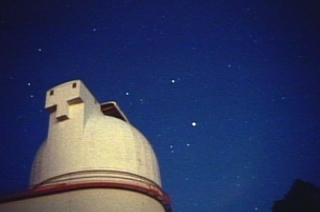Date: 9 November 2007 | Season: Chris Welsby | Tags: Chris Welsby, Systems of Nature
THE NATURE OF OUR LOOKING
Friday 9 November 2007, at 8:40pm
London BFI Southbank NFT2
Moving from ocean to sky and back to the land, these six films respond to nature in less programmatic ways. Peter Hutton’s camera explores the coastal landscape and swirling waters of the Irish West Coast, whilst David Gatten immerses raw film stock in seawater, allowing the ocean to inscribe its presence in constantly shifting abstract patterns. Three films use time-lapse and long exposure to reveal the celestial mysteries of night time, and the final work gently lifts us from our reverie with an ecological warning.
Peter Hutton, Looking At The Sea, 2001, 15 min
David Gatten, What The Water Said, Nos 4-6, 2006, 17 min
Lucy Reynolds, Lake, 2007, 12 min
Emily Richardson, Redshift, 2001, 4 min
Jeanne Liotta, Observando El Cielo, 2007, 17 min
Michael Robinson, You Don’t Bring Me Flowers, 2005, 8 min
Curated by Steven Ball, Mark Webber and Maxa Zoller.
PROGRAMME NOTES
THE NATURE OF OUR LOOKING
Friday 9 November 2007, at 8:40pm
London BFI Southbank NFT2
LOOKING AT THE SEA
Peter Hutton, USA, 2001, 16mm, b/w, silent, 15 min
Most people go to films to get some kind of hit, come kind of overwhelming experience, whether it’s like an amusement park ride or an ideological, informational hit that gives you a critical insight into an issue or an idea. But for those few people who feel they need a reprieve occasionally, who want to cleanse the palate a bit, whether for spiritual or physiological regions, these films seem to be somewhat effective. (Peter Hutton, interviewed by Scott MacDonald in “A Critical Cinema 3”)
WHAT THE WATER SAID NOS 4-6
David Gatten, USA, 2006, 16mm, colour, sound, 17 min
What the water said is literally inscribed on the strips of unexposed celluloid that Gatten cast into the Atlantic Ocean off the coast of South Carolina. Encased in crab traps, the fragmented filmstrips harbour mystical messages from the underwater world, a source of seemingly never-ending fascination. The sea, its salt, sand and rocks, and its gnawing creatures have created the film’s inimitable textured patterns and sounds, while passages from Western literature’s greatest sea odysseys – from “The Life and Adventures of Robinson Crusoe” to “Moby Dick” – remind us of the sea’s singular place in our imagination. (Toronto International Film Festival)
www.davidgattenfilm.com
LAKE (NOCTURNE)
Lucy Reynolds, UK, 2007, 16mm, b/w, silent, 12 min
Lake (nocturne) is a study of the interplay of artificial light with the changing patterns and movements in nature, exploring the illuminations and obfuscations that occur in landscape after dark. The shadowy forms of landscaped lake and parkland also resonate with past narratives of the pleasure garden, recalling the original meaning of nocturne as a term for music composed to be performed at night-time, as accompaniment to the illuminated tableaux, spectacles and fétes of grand gardens, evoking a lost domain. (Lucy Reynolds)
REDSHIFT
Emily Richardson, UK, 2001, 16mm, colour, sound, 4 min
In astronomical terminology ‘redshift’ is a term used in calculating the distance of stars from the earth, hence determining their age. Redshift attempts to show the huge geometry of the night sky and give an altered perspective of the landscape, using long exposures, fixed camera positions, long shots and time-lapse animation techniques to reveal aspects of the night that are invisible to the naked eye. It takes these formal concerns into an emotional realm and uses the figurative to express philosophical ideas about our relationship to the world. The film has a gentle intensity to it, and is composed of changes of light across the sea, sky and mountains. It shows movement where there is apparent stillness, whether in the formation of weather patterns, movement of stars, the illumination of a building by passing car headlights or boats darting back and forth across the sea’s horizon. The sound has been composed for the film by Benedict Drew, taking field recordings of the aurora borealis as a starting point, and using purely computer generated sound to create a soundtrack that reflects the unheard elements present in the Earth’s atmosphere. (LUX)
www.emilyrichardson.org.uk
OBSERVANDO EL CIELO
Jeanne Liotta, USA, 2007, 16mm, b/w & colour, sound, 17 min
I refer to my films of the night sky as “16mm celestial field recordings” to reinforce their non-fiction status … This work is not metaphor but document. Even that light which travelled so far and so long to reach us makes its mark directly upon the emulsion … The subject of my work is perception itself, though it is variously manifested through attention to landscape, pure abstraction, the body in space, cinema itself, or, in Observando El Cielo, with systems such as Science. This extends into the found film and historical/educational footage, as testimonials to the limits of our understanding at any given time. The world itself is something we find, over and over again, and interpret it each time in a different way. (Jeanne Liotta)
www.jeanneliotta.net
YOU DON’T BRING ME FLOWERS
Michael Robinson, USA, 2005, 16mm, colour, sound, 8 min
Viewed at its seams, a collection of National Geographic landscapes from the 1960s and 1970s conjures an obsolete romanticism currently peddled to propagate entitlement and individualism from sea to shining sea; the slideshow deforms into a bright white distress signal. (Michael Robinson)
www.poisonberries.net
Back to top
